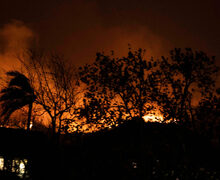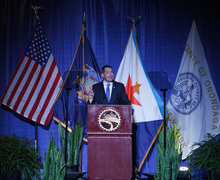Scholarship commemorates students after 18 years
When tragedy struck Syracuse University in 1988 with the deaths of 35 SU students aboard flight Pan Am 103, the school wasted no time in ensuring that the lives, though lost, would not be forgotten.
‘As soon as Pan Am 103 happened, people realized that we needed to remember,’ said Judy O’Rourke, Remembrance Week coordinator. ‘So we immediately thought about ways we could do that. And one obvious way was through a scholarship. It’s just kind of a natural way to do things at SU.’
The Remembrance Scholarship that followed was created in 1989, a year after the airplane bombing, and awards $5,000 to scholars during their senior year. The scholarship’s first 35 recipients, each representing a victim of the event, appeared in the spring of 1990.
Application guidelines have remained unchanged for the past 20 years. Candidates apply in November through January of their junior year, and fill out the paperwork for the first part of the application, which includes essay questions, a list of work and volunteer activities, and peer or faculty recommendations. If selected from this pool, students move on to interviews in March and April.
Former Remembrance Scholars and administrative members of the selection committee conduct the interviews. The applicants chosen for the scholarship are notified at the end of April.
One essay question that regularly appears on the application asks candidates to research a victim’s background and find points of relatable interest or identification.
Marlene Goldenberg, SA president and a 2008-2009 Remembrance Scholar, recalled the hours she spent sifting through the library’s files on the victims for her research.
‘It’s hard to describe. You go up in the archives by yourself, and it’s very quiet, and you’re poring through boxes of these people’s lives,’ she said. ‘It’s kind of this creepy experience, because you get to know so much about these people through their diaries, letters to parents … it’s the kind of access that you don’t even have to your best friend’s life.’
Samantha Harmon, a senior sculpture major and a Remembrance Scholar, said she connected to the student she chose on a personal level through their shared interests.
‘I found a student who was an art major, too, and I saw a poster (she made) in Shaffer,’ she said. ‘You make this personal connection to something you hear about on a large scale, but you focus on one person and begin to distinguish them from the mass. You understand that they were just like yourselves, with family and friends, but lost them.’
After the research and application are completed, the selected students become Remembrance Scholars and plan and execute the annual Remembrance Week. This includes the rose laying ceremony and other activities on campus.
Suzanne Thorin, dean of E.S. Bird Library and chair of the selection committee, described the difficulty in choosing only 35 scholars from the group of applicants.
‘You get to the interview point and they’re just this absolutely top group of students. They have energy, intelligence, creativity and confidence,’ she said. ‘It’s really an embarrassment of riches sometimes in terms of the students we have to choose.’
Goldenberg said the active roles scholars play in campus organizations sometimes lead to tense situations with people vying to be heard at group meetings.
‘I think anytime you have so many people of the same personality in the room, it’s a recipe for disaster,’ she said. ‘But everyone understands that their need to control the situation is secondary to the purpose of us actually being together and commemorating the legacy of other students. Even though we do all these things on campus, this isn’t really about us.’
Published on October 22, 2008 at 12:00 pm





